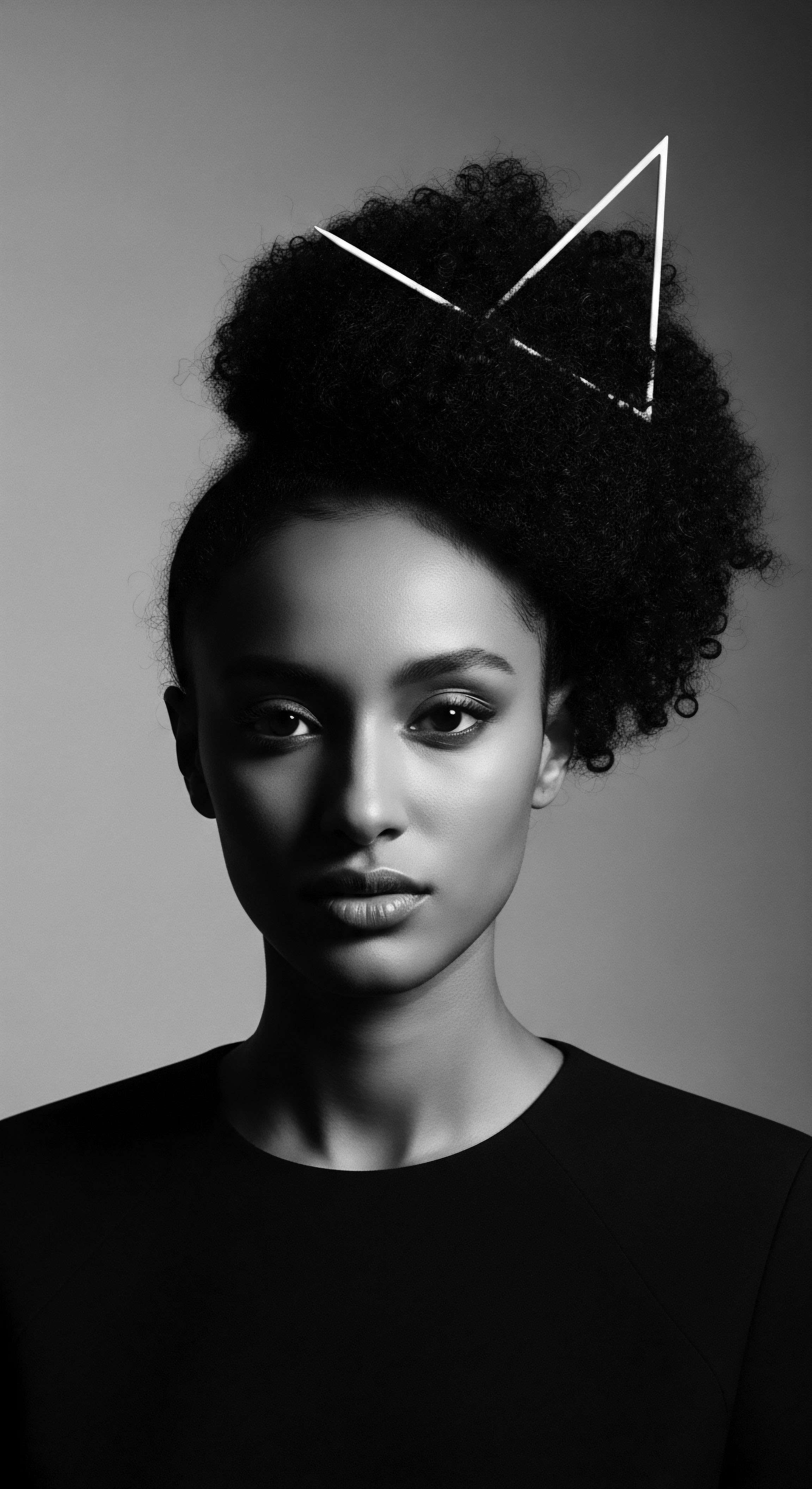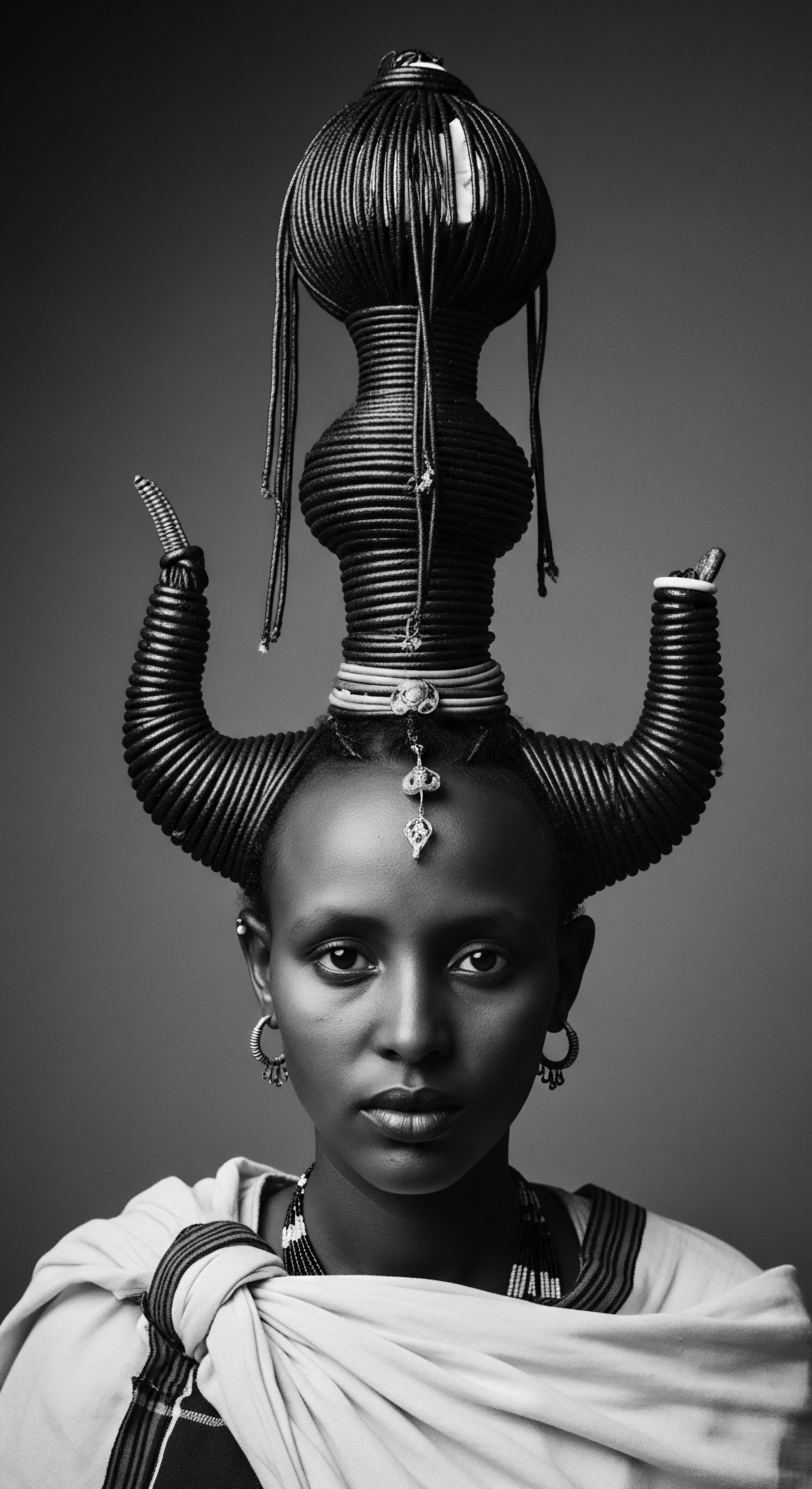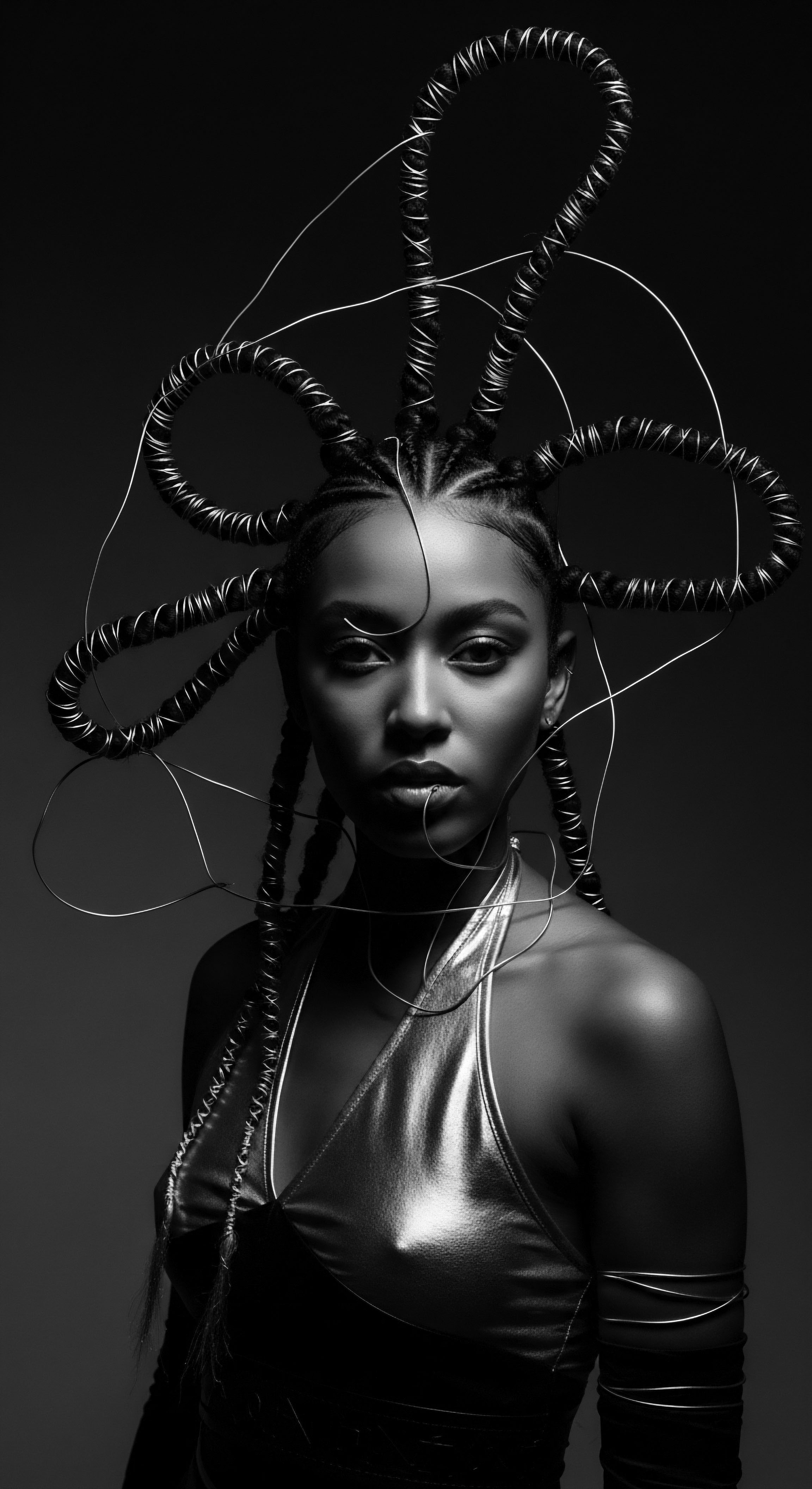
Fundamentals
The concept of Meshwesh Hair Heritage draws us into a rich tapestry of history, connecting us with the ancient Libyan tribe known as the Meshwesh, or Ma, who left an indelible mark on North African civilization. This heritage speaks to the ancestral roots of textured hair care, its deep cultural significance, and the enduring practices passed down through generations. To grasp its fundamental meaning, we first journey to the sun-drenched landscapes of the western Libyan Desert and Cyrenaica, the ancestral homeland of these Berber-speaking people. The Meshwesh emerged as a distinct group, their identity intricately woven with their nomadic, pastoralist lifestyle, relying on goats, camels, and other livestock for sustenance, shelter, and clothing.
From the earliest recorded encounters, ancient Egyptian sources depicted the Meshwesh with distinctive hairstyles, offering a glimpse into their aesthetic and social expressions. These initial accounts often described Meshwesh men adorned with long hair, frequently featuring longer side locks at the front. This particular styling was more than a mere fashion choice; it likely conveyed tribal affiliation, social standing, or spiritual connection, a common thread in ancient African societies where hair was a profound communicative medium. The appearance of these side locks provides a foundational understanding of Meshwesh hair as a marker of their unique cultural identity, setting them apart in the visual lexicon of their ancient neighbors.
The Meshwesh Hair Heritage, in its simplest interpretation, encompasses the traditional hair practices, aesthetic preferences, and the deep symbolic value attributed to hair by the ancient Meshwesh people. It is an acknowledgment that our hair, particularly textured hair, carries echoes of ancient practices and philosophies. This heritage begins to illustrate how early communities understood hair not merely as biological outgrowth, but as a living canvas for personal and communal narratives. The earliest Meshwesh coiffures, with their long strands and specific arrangements, serve as a testament to an original engagement with one’s bodily expression, an elemental understanding of selfhood intertwined with communal recognition.

Hair as Identity and Kinship
Within ancient African civilizations, hair often transcended individual adornment, embodying a deeper communal and spiritual significance. The way hair was styled could communicate a person’s age, marital status, ethnic identity, social rank, or even religious beliefs. For the Meshwesh, this likely held true.
Their distinct hairstyles, particularly the long hair and side locks seen in early Egyptian depictions, likely acted as clear identifiers within their own communities and to external observers. This visual language of hair solidified bonds of kinship and belonging, creating a visible heritage that spoke volumes about an individual’s place within the collective.
The practice of hair care in these ancient contexts was often a communal activity, passed from elder to youth, fostering intergenerational connection and the transfer of ancestral wisdom. It was a time for shared stories, for teaching, and for reinforcing cultural norms. The simple act of tending to hair, whether through braiding, oiling, or shaping, became a living ritual, anchoring individuals to their lineage and the accumulated knowledge of their forebears.
The Meshwesh, as nomadic hunter-pastoralists, would have developed practices suited to their environment and lifestyle, relying on available natural resources for cleansing, conditioning, and styling their hair. These elemental approaches to hair care stand as early expressions of a deep human connection to natural well-being.
The Meshwesh Hair Heritage describes the ancestral hair practices and symbolic meanings rooted in the ancient Libyan Meshwesh tribe, highlighting hair as a central marker of identity and lineage.

Echoes from the Source ❉ Hair Biology and Ancient Practices
Even in the earliest human history, the relationship between hair’s biological properties and its care was implicitly understood. Textured hair, prevalent across Africa, naturally forms coils, curls, and waves, offering unique characteristics that influenced ancient styling and maintenance. The density, elasticity, and inherent need for moisture in textured hair guided the development of specific practices. The long hair of the early Meshwesh would have necessitated particular attention to prevent tangling and maintain health, likely involving natural emollients and careful manipulation.
Archaeological findings from the broader North African region, including ancient Egypt, illuminate the sophisticated understanding of hair care. Egyptians, for example, used tools for hair removal, intricate combs, and even wigs as early as 3400 BCE. They employed various substances to augment and style hair, including fatty materials as a type of styling gel. This suggests a practical and aesthetic engagement with hair that extended beyond mere functionality.
The Meshwesh, residing near and eventually within Egyptian territories, would undoubtedly have engaged in similar practices or developed their own parallel methods, adapting them to their specific hair types and cultural norms. The foundations of their hair heritage begin with this ancient, practical connection to the natural qualities of textured hair and the environment it existed within.

Intermediate
Expanding our understanding of the Meshwesh Hair Heritage, we observe its dynamic evolution through interactions with neighboring civilizations, most notably the Egyptians. While early depictions showcased long hair with side locks, later representations reveal a noticeable shift ❉ Meshwesh individuals are depicted with shorter hair, often braided and intricately beaded, sometimes adorned with one or two feathers fastened around the crown on leather bands. This transformation suggests a cultural exchange, where Egyptian influences on aesthetics and hair styling were absorbed and reinterpreted by the Meshwesh, creating a nuanced expression of their identity within a changing socio-political landscape.
The movement of the Meshwesh into the Western Delta region of Egypt during the late 21st Dynasty and their eventual establishment of the 22nd Dynasty brought about an intensive period of cultural intermingling. This was not a one-sided adoption; the Meshwesh brought their own cultural aspects and traditions to Egypt, influencing Egyptian art, architecture, and religious practices, even as they incorporated Egyptian customs into their own belief systems. Their hair, therefore, became a visible chronicle of this evolving cultural identity, a blend of ancestral forms and newly adopted techniques, demonstrating remarkable adaptability and cultural resilience. This era marks a significant phase in the Meshwesh Hair Heritage, underscoring its capacity for evolution while retaining a core connection to its origins.

Cultural Exchange and Hair Adornment
The intricate braids and beads observed in later Meshwesh representations speak to a widespread and deeply rooted practice of hair adornment across African cultures. These elements were not merely decorative; they were potent symbols. Beads, shells, and other natural materials incorporated into hairstyles often conveyed specific meanings related to status, wealth, or spiritual protection.
The addition of feathers, as seen in Meshwesh coiffures, could have signaled prowess, leadership, or a connection to specific totemic animals. This practice of embellishing hair transformed it into a living artifact, a testament to personal narrative and communal values.
Beyond aesthetics, hair styling often served practical purposes, particularly for textured hair. Braids and other structured styles could protect the hair from environmental elements, reduce tangling, and minimize breakage, thereby preserving length and health. The communal activity of braiding, often involving hours of careful work, fostered social bonds and served as a vehicle for oral traditions and shared knowledge. The Meshwesh likely engaged in such collective practices, strengthening community ties through these shared rituals of hair care and adornment.
Hair styles among the Meshwesh, evolving from long locks to intricate braids and beads, visibly charted their dynamic cultural interactions and enduring identity.

Ancestral Care and the Science of Preservation
The preservation of hair in ancient contexts provides compelling evidence of sophisticated hair care practices. Research on Egyptian mummies, for instance, has revealed that fatty substances were deliberately applied to hair to maintain styles both in life and in death. Natalie McCreesh and her team, studying hair samples from 18 mummies, including those from the Dakhleh Oasis, found that nine of them had hair coated in a fat-based substance composed of long-chain fatty acids.
This suggests a conscious application of emollients to condition and hold hair in place, a remarkable testament to ancient understanding of hair’s physical properties. The meticulous attention to hair preservation in death, including adapting the embalming process to safeguard hairstyles, underscores the profound importance of hair in conveying individuality and identity even in the afterlife.
The use of oils and natural ingredients for hair health was a widespread ancestral practice across North Africa. For centuries, Amazigh women, who share a heritage with the Meshwesh, have utilized argan oil, derived from the kernels of the argan tree, for both culinary and cosmetic purposes. This “miracle oil,” rich in Vitamin E and essential fatty acids, offers restorative and protective properties for skin and hair.
The painstaking, multi-step process traditionally employed by Amazigh women to extract this oil, often involving hand-malaxing of an aqueous argan kernel dough, speaks to a deep, experiential knowledge of ingredient efficacy and sustainable practice. This demonstrates an early, intuitive form of scientific understanding, where generations observed, experimented, and perfected methods for nurturing hair using what the earth provided.
The archaeological discoveries of combs, some dating back to 3900 BCE, also reveal a continuous legacy of tools specifically designed for managing textured hair. The wider spacing between the teeth of ancient African combs, compared to European counterparts, suggests an awareness of textured hair’s fragility and propensity for breakage. These tools, found in burial sites, served not only practical functions but also held symbolic value, embodying status and personal adornment. They are tangible links to the hands that once cared for and styled hair within the Meshwesh lineage, a quiet testament to their enduring practices.

Academic
The Meshwesh Hair Heritage represents a complex confluence of ethnohistorical accounts, archaeological findings, and the enduring principles of traditional hair care practices, profoundly shaped by the socio-cultural dynamics of ancient North Africa. Its academic delineation transcends a simplistic description of hairstyles; it is an exploration of how corporeal expression, particularly hair, served as a primary semiotic system within and beyond the Meshwesh polity. Originally identified in Egyptian texts from the Eighteenth Dynasty as a distinct Berber-speaking tribal confederation, the Meshwesh (or Ma) inhabited the ecologically diverse western Libyan Desert and Cyrenaica.
Their presence on the periphery of the Egyptian state gradually transitioned into a more integrated, and ultimately dominant, role within the Nile Valley, culminating in the establishment of the Twenty-Second Dynasty. This historical trajectory illuminates how their hair practices, initially depicted as long and flowing with distinctive side locks, underwent a visible evolution, absorbing influences from Egyptian aesthetics, resulting in more intricate braided and beaded styles, often accented with feathers.
This morphing of coiffure from indigenous forms to hybridized expressions is a powerful testament to cultural adaptation and resilience, a phenomenon of sustained identity within shifting power structures. The interpretation of hair, therefore, moves beyond a purely aesthetic domain, becoming a critical lens through which to examine processes of cultural assimilation, resistance, and the negotiation of power in antiquity. Hair served as a mutable, yet persistently meaningful, site of self-representation, a visible dialogue between inherited custom and external influence. This dynamic interplay offers a robust field for academic inquiry, connecting ancient practices with contemporary discussions on heritage and identity within Black and mixed-race communities globally.

Hair as a Cultural Repository ❉ Beyond Adornment
Academic inquiry into the Meshwesh Hair Heritage necessitates an understanding of hair’s pervasive symbolic weight in ancient African societies. Hair was rarely a neutral element. It functioned as a communicative medium, denoting an individual’s familial lineage, tribal affiliation, social standing, age, marital status, and even spiritual disposition.
For the Meshwesh, early depictions of their distinct long hair with side locks conveyed group identity and perhaps a certain spiritual connection to their nomadic lifestyle, where hair might have been seen as a conduit for spiritual energy, as is believed in some African cosmologies. This profound connection meant that the styling and maintenance of hair were often ritualized activities, imbued with specific protocols and performed within communal settings, solidifying social cohesion and transmitting cultural narratives across generations.
When the Meshwesh began to settle in and exert influence over parts of Egypt, their hair practices began to reflect this new reality. The adoption of shorter, braided styles and the incorporation of beads and feathers, as seen in later artistic representations, suggest a deliberate synthesis of Meshwesh identity with elements of Egyptian elite aesthetics. This was not a passive imitation; rather, it appears to have been an active re-contextualization, where foreign elements were integrated into an existing framework of meaning, creating new visual statements of power and cultural synthesis. Such hybridity in corporeal expression highlights the complexity of identity formation in zones of cultural interaction, revealing how people assert continuity while absorbing external influences.

The Biophysical and Ritualistic Dimensions of Care
A rigorous academic approach to the Meshwesh Hair Heritage also demands an appreciation for the intersection of elemental biology and ancient care practices. Textured hair, with its unique coiling patterns and inherent need for hydration, prompted the development of sophisticated techniques for its maintenance. The archaeological record from North Africa provides compelling insights into these ancestral methodologies. For instance, studies on mummified remains from various Egyptian sites, including the Dakhleh Oasis, illustrate a deliberate and precise application of lipid-based substances to hair.
Researchers analyzing hair samples from ancient Egyptian mummies documented the presence of fatty acids, indicating the use of styling products that helped to set and preserve hair in place. This discovery validates an ancient understanding of hair conditioning and structure, where naturally occurring animal fats or plant oils were utilized to achieve desired aesthetic and practical outcomes. The conscious effort to protect and style hair even in the embalming process further underscores hair’s profound cultural significance, its role in maintaining individuality and personal identity beyond life. This provides a material basis for understanding the Meshwesh approach to hair, suggesting that similar environmental adaptations and practical wisdom would have guided their own care rituals.
A particularly illuminating case study connecting ancient North African hair practices to textured hair heritage is the centuries-old tradition of Argan Oil production and application among the Amazigh (Berber) women, who share a direct ancestral lineage with the Meshwesh. The argan tree (Argania spinosa), endemic to southwestern Morocco, has been a cornerstone of Amazigh life for generations, providing sustenance, fuel, and a cherished cosmetic oil. Traditionally, the laborious process of extracting argan oil involves hand-malaxing argan kernels, a meticulous ritual passed down through matrilineal lines, embodying embodied knowledge and communal solidarity. This oil, rich in unsaturated fatty acids, polyphenols, and Vitamin E, was revered for its nourishing and protective properties for skin and hair.
The use of argan oil by Amazigh women exemplifies ancestral wisdom, offering a compelling case study of traditional hair care practices deeply embedded in North African heritage.
A crucial statistic powerfully illuminates the deep connection between this ancestral practice and contemporary challenges to heritage preservation ❉ The Argan Forest, Once Covering Vast Expanses, Has Shrunk by an Estimated 50% over the Last 100 Years, prompting UNESCO to declare it a biosphere reserve in 1998. This decline, largely anthropogenic, underscores the fragility of ecological systems that underpin indigenous knowledge and traditional practices. The continued, often cooperative-based, production of argan oil by Amazigh women today, even with modern mechanical extraction methods, represents a sustained effort to preserve this invaluable natural resource and the cultural heritage tied to its use. The oil’s traditional application for hair protection, promoting strength and luster, is a testament to an ancestral understanding of natural emollients for textured hair.
This provides a direct, rigorously backed historical example of how ancient North African practices continue to address specific needs of textured hair, linking elemental biology with a profound cultural legacy. The enduring relevance of argan oil in modern textured hair care products speaks to the scientific validation of this inherited wisdom, bridging millennia of practice with contemporary wellness paradigms.
| Traditional Practice / Element Long Hair & Side Locks |
| Historical Application (Meshwesh/North Africa) Early Meshwesh men's distinctive styles, likely denoting tribal identity and spiritual connection. |
| Modern/Scientific Link to Textured Hair Reflects a valuing of natural length and a recognition of hair as a profound personal and collective statement of heritage. |
| Traditional Practice / Element Braids & Beads |
| Historical Application (Meshwesh/North Africa) Later Meshwesh styles, demonstrating cultural exchange with Egypt and serving as markers of social status or spiritual significance. |
| Modern/Scientific Link to Textured Hair Protective styling for textured hair, minimizing manipulation and breakage, a practice still central to healthy hair maintenance in Black/mixed hair communities. |
| Traditional Practice / Element Fat-Based Gels/Oils |
| Historical Application (Meshwesh/North Africa) Application of lipid substances by ancient Egyptians to set and preserve hairstyles in life and death. |
| Modern/Scientific Link to Textured Hair Early form of conditioning and styling agents for textured hair, preventing dryness and aiding manageability, echoing modern leave-in conditioners and emollients. |
| Traditional Practice / Element Argan Oil |
| Historical Application (Meshwesh/North Africa) Centuries-old use by Amazigh women for hair nourishment and protection; a cornerstone of traditional Berber beauty. |
| Modern/Scientific Link to Textured Hair Rich in antioxidants and fatty acids, scientifically proven to protect the hair shaft and improve hydration, a valued ingredient in contemporary textured hair products. |
| Traditional Practice / Element Combs (Wide-Toothed) |
| Historical Application (Meshwesh/North Africa) Archaeological finds demonstrating comb use as early as 3900 BCE; wider gaps in African combs suggest awareness of textured hair fragility. |
| Modern/Scientific Link to Textured Hair Essential tool for gentle detangling of coiled and curly hair, preventing damage and preserving strand integrity, a direct lineage to modern wide-tooth combs. |
| Traditional Practice / Element The continuum of hair care, from ancient Meshwesh and Berber traditions to present-day practices, underscores an unbroken chain of ancestral wisdom guiding textured hair wellness. |

Interconnected Incidences ❉ Hair as a Symbol of Resistance and Continuity
The academic discourse surrounding Meshwesh Hair Heritage can further analyze its interconnectedness with broader narratives of Black and mixed-race hair experiences, particularly concerning resistance and cultural continuity. The forced shaving of hair during the transatlantic slave trade, intended as a dehumanizing act and a deliberate stripping of identity, highlights the profound symbolic value of hair in African cultures. This historical trauma emphasizes how deeply hair was intertwined with selfhood and communal identity. For descendants of enslaved Africans, the reclaiming of natural textured hair styles today represents a powerful act of self-affirmation and a reconnection to ancestral heritage, mirroring the resilience observed in the Meshwesh adapting their hair expressions through time.
The enduring presence of hair braiding techniques, for instance, found in ancient Egyptian hieroglyphics as early as 3500 BCE and observed in various forms across the continent, including Ghana braids, Fulani braids, and Bantu knots, speaks to an unbroken lineage of innovation and cultural preservation. These styles, often carrying specific meanings of community, age, or marital status, exemplify a living heritage that transcends geographic and temporal boundaries. The Meshwesh experience, with its documented shifts in hair styling reflecting cultural exchange and adaptation, provides an early historical precedent for the dynamic, yet deeply rooted, nature of textured hair expression. It suggests that even in periods of significant external influence, the core value of hair as a marker of identity and a vessel of ancestral wisdom persisted, evolving but never truly diminishing.

Reflection on the Heritage of Meshwesh Hair Heritage
The journey into the Meshwesh Hair Heritage reveals a profound and continuous narrative, one that echoes through the generations of textured hair traditions. It is a meditation on the enduring power of hair not simply as a biological attribute, but as a living archive, a sacred thread woven with the wisdom of our ancestors. From the distinctive long locks of early Meshwesh men to the intricate braids and beaded styles reflecting cultural synthesis with ancient Egypt, their hair tells a story of adaptation, resilience, and unwavering identity amidst evolving landscapes. This heritage reminds us that hair care practices, born from necessity and nurtured by collective wisdom, formed the very bedrock of cultural expression and well-being for centuries.
The meticulous care given to hair in antiquity, from the purposeful application of fat-based emollients found on mummified remains to the centuries-old ritual of argan oil extraction by Amazigh women, speaks volumes about a deep, intuitive science. These practices, seemingly simple, held complex layers of understanding concerning hair’s elemental biology and its interaction with the natural world. They underscore a holistic approach to wellness, where external care intertwined with spiritual connection and communal bonding. The preservation of these techniques, whether through archaeological evidence or continued traditional practices, offers invaluable lessons for contemporary textured hair care, urging a return to natural ingredients and mindful rituals.
As we observe the resurgence of natural hair movements today, a powerful connection to the Meshwesh Hair Heritage emerges. It is a shared recognition that our hair carries not only aesthetic beauty but also a profound historical weight, a legacy of defiance, creativity, and self-acceptance. The choices we make about our hair today, whether we choose to braid, coil, or simply let it flow, inherently connect us to this ancient lineage, affirming a continuous conversation with our past. The Meshwesh Hair Heritage stands as a vibrant testament to the ingenuity and spiritual depth of ancient North African peoples, reminding us that the ‘soul of a strand’ is indeed an unbound helix, ever spiraling through time, carrying the whispers of ancestry into our future.

References
- Byrd, Ayana D. and Lori L. Tharps. Hair Story ❉ Untangling the Roots of Black Hair in America. St. Martin’s Press, 2001.
- Charrouf, Zoubida, and Dominique Guillaume. “Argan oil ❉ an exceptional forest tree endemic to Morocco.” OCL 17.5 (2010) ❉ 253-261.
- Fletcher, Joann. Ancient Egyptian Hair and Hairdressing. British Museum Press, 2004.
- McCreesh, Natalie C. et al. “A practical application of analytical chemistry to ancient Egyptian mummy hair ❉ evidence for the use of styling products.” Journal of Archaeological Science 38.10 (2011) ❉ 2715-2719.
- Omotos, Adetutu. “The History of African Hair.” Journal of Pan African Studies 11.7 (2018) ❉ 18-32.
- Pinch, Geraldine. Votive Offerings in Ancient Egypt. Ashgate Publishing, Ltd. 1993.
- Riggs, Christina. Unwrapping Ancient Egypt. Bloomsbury Academic, 2014.
- Robins, Gay. The Art of Ancient Egypt. Harvard University Press, 1997.
- Sherman, Elizabeth J. The History of African Hair Braiding. LEAFtv, 2017.
- Shaw, Thurston. Igbo-Ukwu ❉ An Account of Archaeological Discoveries in Eastern Nigeria. Northwestern University Press, 1970.
